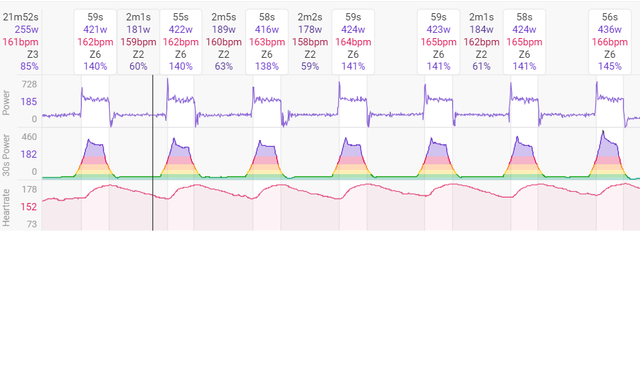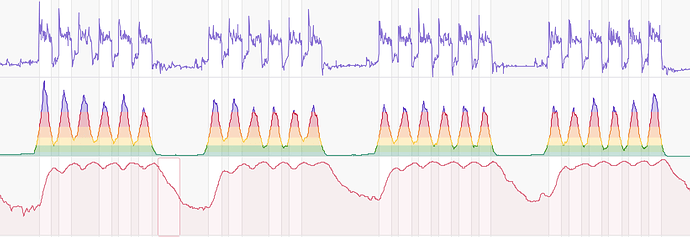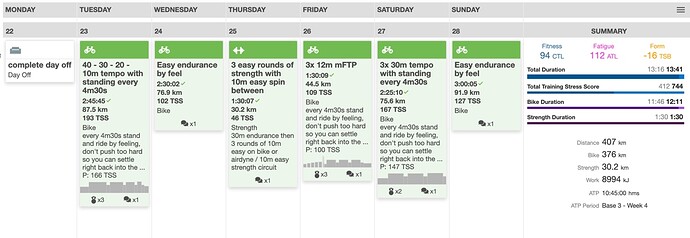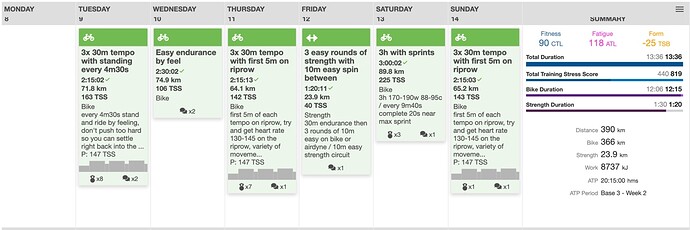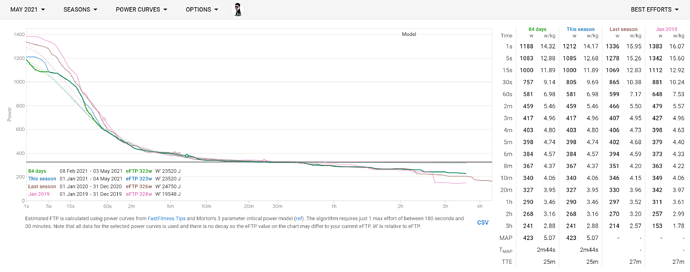One other addendum to the above. The weather finally warmed up the past week+ to get in some outdoor rides. Basically the same ~2h endurance rides on the gravel bike as last fall where I was riding around 135W ave at 105-110 bpm, I’m now at ~150W at that same HR window.
I am in the same boat(or house), I recent look back has my FTP between 83-86% of vo2max over the last 3 years! I apparently have been slamming my head into the ceiling(easy to do, I am 6’-4"). So, I have already, as suggested below doing two focused Vo2max workouts a week.
As a personal, general training philosophy, the things we hate to do, are the things we need to do the most. I would work on your long efforts at vo2, so yes suck it up! I am doing both being a mtb/cx guy, short/shorts dominate out racing/terrain here, but the long sustained efforts add a greater mental challenge for me.
Couldn’t agree more on the comment about “the things we hate to do are the things we need to do.” Being a MTB guy myself, and @trevor knows this, I loath anything over ~5 minutes. Whenever I attempt to stay on his wheel in the canyons around Boulder it’s a sufferfest for those 40+ minute slogs uphill. He’s loving it; me, not so much. But when the work gets done, the payoff is huge! Definitely appreciate the mental challenge too. It’s not enjoyable, but if you’re required to do it in events, you better practice it. 
Coach Ryan
Hi All,
Apologies for going dark on this one! Work has got in the way of Fun just lately!
Interesting chat, and good to know I’m not on my own here, I’ve also been doing some digging and stumbled across this resource (http://powerspeedprofile.com/). I’ve not done the formal test protocols yet (going to do that next week which will be interesting) but plugged the data from my last seasons power curve into it, as that was pretty well defined. In essence, it’s reconfirmed my issue above, that going at 115% FTP isn’t hard enough for me to target VO2Max and I need to be much closer to 120% (usefully it also gives HR targets). Hopefully it’s interesting/useful for others, I’d be interested to hear your thoughts.
The Dr Seiler Short Stacks video was very interesting, my own takeaway from it was that short on/off intervals got significantly more time in zone (power), but didn’t necessarily elicit the CV (stroke volume & ventricular preload) effects that I was targeting. However as with everything, that’s probably not universally true for all. Unfortunately for me, it appears that the longer VO2 intervals will be more likely to trigger the adaptions, and that’s probably also why I prefer (read: find easier) the tabata style workouts. Am I misinterpreting what Dr Seiler was presenting here?
I’m slotting in a couple of structured VO2s a week, and it’ll be interesting to see the results.
When the weather improves, it looks like I’ll be wearing a groove in the local 4-8 minute hills!
Stuart
@ryan and @stuarthardy - thanks for this dialogue. Interesting discussion. Kudos Stuart for having dialed in a perceptible difference btw 160BPM (88% of max HR) and 164BPM (90%). I’ve been wondering a bit about proper targets for HR for both threshold and VO2 workouts. I did 5x5 threshold yest. and avg low-mid 80% of max HR in interval, and peak HR in interval was high 80%. Didn’t hit 90%. Was happy (i think!). For VO2 work upcoming, was thinking 90-95% target, but maybe that’s too high? Ryan noted above that he starts counting above 85-88%. But maybe that’s where individual variability comes in, since Stuart you’e saying that you can hold 88% but not 90%. So, explore what one can hold HR wise for 4x4minutes, and then work on improving that edge? I’ve spent so many years just looking at the power numbers - and have my mental model of my HR abilities left over from running 20 years ago… i suspect i’m inclined to think I can do higher HRs than I really can now that I’m 60. (This all becomes very important for hill climb events later in the year.)
@TKskate, yes, I have a bit of a wider range open for myself. And that lower end is more for my “health” mind, not so much the “athlete” mind where I can still do intervals and put in some hard work, knowing I won’t always hit 90% or higher (e.g., fatigue, day to day changes in HR responsiveness, etc.). On some of those days I might change up the workload and still target something relatively high that will help the fitness in general even though it might not be a perfect interval workout. It’s not likely as large of a response as if I did something like 30:15 or 4x4 type of efforts, but it still works.
This is a workout from ~2 weeks ago that was exactly the scenario. Ended up being 9x5 minutes with 1 min rest at 85-92% of HRmax. HR was not super responsive that day, but still felt good and it just worked out better to target that lower end of the HR range rather than push too much power too early. I was not super well rested for it, but it was still a solid session. DIdn’t hit that >90% HR until the last 3 efforts as fatigue was settling in (as you can see!).
It sounds like you have a good sense for your HR, Tom, having paid attention to it for so many years of training. My take-home is that it’s important to first get in tune with your typical HR responses to different efforts by using real-time experience during workouts and post-exercise analysis. Next, it’s allowing some of that individual variation you mentioned. Once you can work that in, you’ll have a good sense for how to make adjustments, or completely call a workout off if necessary, etc. based on sensations and initial HR response.
Thanks!
Coach Ryan
How we accumulate time at intensity can vary greatly.
5x5min or 4x4min efforts, your heart rate will rise and you will accumulate 3-4 minutes per interval, 12-20 min per workout
Whereas @ThermalDoc will perform Ronnestad 13x 30/15’s, and will have 7-9 minutes per interval set, 20-30 min per workout.
Is it better to have continuous minutes at elevated HR or is total time at intensity the more important principle?
I’ve been performing more intermittent type intervals, 3 sets of 7, 1 min on/ 2 min off.
I have progressed my “ON” power from 120% FTP to 130% to now 140% .
My last work out I accumulated 30+ min over 85% HR max, and 15 min over 90% HR max.
Am I leaving something on the table by not choosing intervals that collect more sustained HR values?
I believe those 1’on / 2’off would target more the anaerobic system than longer ones (3’+) or ones with a 2:1 work:rest ratio (like 30’’/15’’).
Therefore less of an aerobic stimuli maybe?
yes, to your point @shawnfife, what @juliengagne suggested is likely the scenario. The 1 min on / 2 min off structure will allow you to tap into those anaerobic stores pretty heavily from interval to interval with the longer rest periods. I pulled a 40/20 workout from Intervals.icu where that top end power really went away after the first couple intervals. That purple color highlighting the anaerobic zone is very pronounced in your interval set with the 2 min rest periods. In the 40/20 example below, you can see it gradually get tapped out with the short recovery periods.
To your question of leaving something on the table by not chasing intervals that collect more sustained HR values, I think it would help to know what your goal is first. The fact that you’re seeing those gains from 120% to 130% and now 140% for 1 min efforts is pretty significant! If you’re going for improvements in 1 min power, this seems to be working well for you. So in that case, I’d say that no, you don’t seem to be missing anything at the moment. For more sustained high intensity efforts, I would think that the 2 minute rest periods would be on the long side to give you continuous load at your maximal aerobic capacity.
Thank you for those great questions and points!
In the last podcast, Trevor mentioned teaching his athlete to learn to suffer/ride hard during racing.
This idea is part of these intervals for me, my training is mostly made up of endurance and tempo rides. I test using a Ramp Test, 4 min steps, 25 watts per step. I have been ending the test on the 350 watt step, but Xert predicts that I can work well into the 375 watt step.
These efforts have really pushed my breathing/respiration rate and heart rate into uncomfortable levels needed to break through mental, physical, and psychological limits.
Great thread. @ryan one question I have - is the point about using HR to target these intervals that this is more likely to allow you to target your actual VO2 Max on a given day (I’m assuming this exhibits some variability much as (functional) threshold), rather than a ‘best ever’ type number? Or is there something about our bodies’ response to this type of effort that means HR is actually measuring more directly what it is we want to improve (stroke volume etc.)? Or is it both? To be clear on the latter is there a sense in which e.g. at the beginning of an interval if we have a low hr we are not actually causing the desired adaptations until it ‘catches up’ with the work imposed on it (and thus might want to hit the interval hard to begine with)?
Hope that makes sense!
Thanks, @Mr.B. Great question. So I use HR primarily for intervals like these for the same reason I use them in threshold intervals. The power will vary from day to day, but generally the HR response seems to vary less, and I am better able to quickly align power, sensations, and HR to know if the legs are good or not. If they aren’t great, then I know power will be down, but I can likely still achieve the HR response. If the legs aren’t great, and the HR is not increasing as expected, that’s my signal to save that session for another day and get more recovery.
So at the beginning of an interval, we might have a low HR, but we have to look at it in relation to our past response and expected progress. As an example, I’ve been able to get some very good aerobic improvement so far this year, and my HR in VO2 intervals has dropped to a point where it responds relatively quickly and achieves a plateau at a higher power output. Previously, with a less well trained aerobic system, it was easy to shoot the HR up to a higher absolute level and might not plateau as quickly, or at all. So my take-home there is, to your last question, it depends (ugh, sorry!) both on your fitness and on your expected outcome from the session. If you hit the interval hard at the start, that is a great way to work on (for example) specificity for racing, or generate a higher lactate level right away and then work on your ability to tolerate that and combust it at moderate intensities.
I remember listening to some episode which @Sebastian-Weber said you could expect a certain VO2max with a certain amount of leg training hours per week (10h = 60, 15h = 65). The impression that I got is that raising your VO2MAX requires more than just high intensity? Specifically high volumes of low Intensity at the right intensity = foundation for a certain VO2max?
How important is hitting the right intensity for that low volume base in creating a foundation to improve VO2max when you do the high intensity? How important is doing this volume during the same block you do the VO2max intervals vs. just doing it over months / years?
I tend to do primarily endurance and tempo training with my athletes while continuing to test their vo2 ability.
If the endurance and tempo are continuing to raise their vo2 max power, I continue with the same training until I see a plateau. So basically I am always testing the opposite intensity that I am training to see the effect it is having.
Most people find it hard to do such boring training, so they give up a bit sooner than seeing the benefits it can have for them at the top end.
I tend to build a big base with athletes, then pick appropriate races to bring around the top form before they need to peak.
No issues here with loads of easy miles. My main challenge is finding the time to get that in ![]() Regarding building base, then bringing top form, how do you manage that if your goal is also the lowest possible VLAmax (triathlon or steady/long time trials)? VO2max intervals during the off-season, then VLAmax reducing work as you approach races?
Regarding building base, then bringing top form, how do you manage that if your goal is also the lowest possible VLAmax (triathlon or steady/long time trials)? VO2max intervals during the off-season, then VLAmax reducing work as you approach races?
I primarily focus on FatMax and Tempo work. I try and find the ceiling of volume my athletes can each handle and still improve, and also perform well at the higher end.
There are lots of low rpm during the tempo work between 50-75.
For training levels, I would use Insycd Testing every 2-3 months depending on the phase. I also use Moxy Monitor (muscle oxygen monitoring daily), this allows for the best training each day with fluctuations we all experience in our bodies.
Below is an example of a pretty normal week. 58-year-old mtb rider, stage race and long race focus.
Normal week.
Harder week examples below.
This athlete tends to have a higher VlaMax of .55 - .62 so it takes a lot to keep it around .45. Could keep it lower without the strength but it is very important for his well-being and mountain bike riding. He is also able to podium in his key race each year with his test levels so I like to keep the strength with him.
I do blocks of a few months of really steady riding in FatMax until it plateaus with this athlete usually around 225w. Then I would move to include tempo as you see in the examples.
I’m a bit confused now. If the goal is highest VO2max + lowest VLAmax, how are you accomplishing that with this example (which would only be lowering VLAmax)? VO2max work off-season?
Going back to the OP, if the point is to increase his Ceiling (VO2max), I was just wondering if there also needs to be a focus on the right intensity and quantity of low-intensity volume to do just that? Since he didn’t share his VO2max/weight, I was just a bit curious if it was also possible that he just wasn’t doing enough easy volume to bring his ceiling up any more (since he did mention ~9hr week at one point).
I rarely do vo2 max work, with this specific athlete, 70kg, 58 years old.
I will do 2-3 week blocks of vo2 max when the vo2 max or higher intensity plateaus from the endurance/tempo training.
So I have most of my athletes on this type of plan which is focus on endurance and tempo until vo2 or higher plateaus. Then I do a 2-3 week block of training to try and raise those ceilings, then go back to the other training.
Not sure if that answers the questions but just an example of how I go about things.
This is a really interesting digression from the original post, which leads me to another question, which is partly triggered by relistening to Episode 68 (The 3 types of rides you should do).
As @smashsquatch pointed out, I was capped at a maximum of 11 hours per week, with 7-9 hours being more realistic, particularly during the summer when work is busiest for me.
Is this just too few hours a week to effectively use polarised?
20% of 9 hours is only around 90 minutes of intervals a week, with the remaining ~7 hours being Z2. I’m not sure I’ll hit a high enough TSS to improve at that? Or am I completely missing the mark here and my body is likely governing my ability to progress from doing closer to 4 hours of intervals and 4 hours of Z2 (give or take!).
In response to the question regarding weight/VO2, I’ve not lab tested VO2 but weight is ~83kg and FTP is around 320w, with a best 5 minute effort of ~400w (4.75wkg). On a ramp test (20w, 1min steps) I usually pop somewhere around the 420-440w interval. If anyone can estimate based on any of that?
@stuarthardy would you mind telling me a little bit about the 80% training breakdown, just a few months of example? It looks like you are using intervals.icu could you screenshot like the one below of your totals and power zones over a recent time period.

